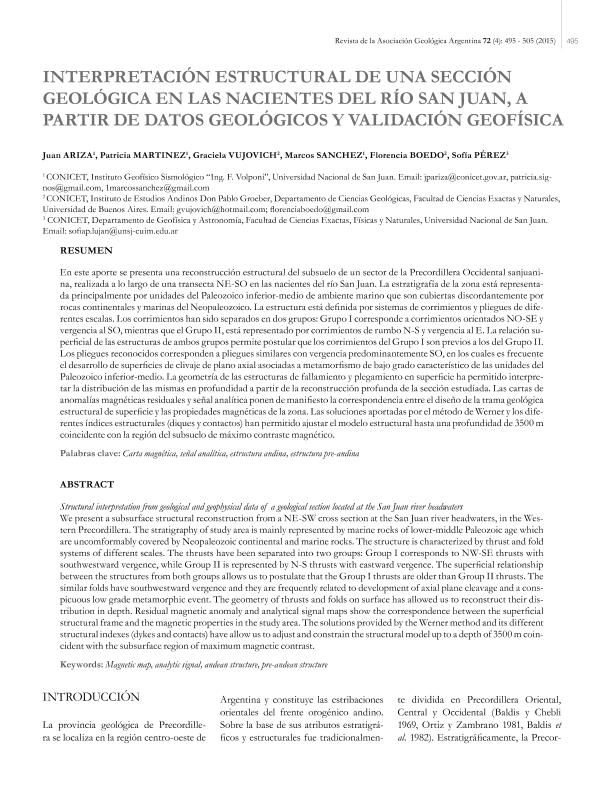Artículo
En este aporte se presenta una reconstrucción estructural del subsuelo de un sector de la Precordillera Occidental sanjuanina, realizada a lo largo de una transecta NE-SO en las nacientes del Río San Juan. La estratigrafía de la zona está representada principalmente por unidades del Paleozoico inferior-medio de ambiente marino que son cubiertas discordantemente por rocas continentales y marinas del Neopaleozoico. La estructura está definida por sistemas de corrimientos y pliegues de diferentes escalas. Los corrimientos han sido separados en dos grupos: Grupo I corresponde a corrimientos orientados NO-SE y vergencia al SO, mientras que el Grupo II, está representado por corrimientos de rumbo N-S y vergencia al E. La relación superficial entre las estructuras de ambos grupos permite postular que los corrimientos del Grupo I son previos a los del Grupo II. Los pliegues reconocidos corresponden a pliegues similares en los cuales es frecuente el desarrollo de planos de clivaje de plano axial asociado a metamorfismo de bajo grado característico de las unidades del Paleozoico inferior-medio. La relación que existe entre las estructuras de fallamiento y plegamiento en superficie ha permitido interpretar la distribución de las mismas en profundidad a partir de la reconstrucción profunda de la sección estudiada. El filtrado de anomalías magnéticas y la elaboración de las cartas magnéticas de anomalía residual y señal analítica ponen de manifiesto la correspondencia entre el diseño de la trama geológica estructural de superficie y las propiedades magnéticas de la zona. Las soluciones aportadas por el método de Werner y los diferentes índices estructurales han permitido ajustar el modelo estructural de subsuelo. We present a subsurface structural reconstruction from a NE-SW cross section at the San Juan river headwaters, in the Western Precordillera. The stratigraphy of study area is mainly represented by marine rocks of lower-middle Paleozoic age which are uncomformably covered by Neopaleozoic continental and marine rocks. The structure is characterized by thrust and fold systems of different scales. The thrusts have been separated into two groups: Group I corresponds to NW-SE thrusts with southwestward vergence, while Group II is represented by N-S thrusts with eastward vergence. The superficial relationship between the structures from both groups allows us to postulate that the Group I thrusts are older than Group II thrusts. The similar folds have southwestward vergence and they are frequently related to development of axial plane cleavage and a conspicuous low grade metamorphic event. The geometry of thrusts and folds on surface has allowed us to reconstruct their distribution in depth. Residual magnetic anomaly and analytical signal maps show the correspondence between the superficial structural frame and the magnetic properties in the study area. The solutions provided by the Werner method and its different structural indexes (dykes and contacts) have allow us to adjust and constrain the structural model up to a depth of 3500 m coincident with the subsurface region of maximum magnetic contrast.
Interpretación estructural de una sección geológica en las nacientes del río San Juan, a partir de datos geológicos y validación geofísica
Título:
Structural interpretation from geological and geophysical data of a geological section located at the San Juan river headwaters
Ariza, Juan Pablo ; Martínez, Myriam Patricia
; Martínez, Myriam Patricia ; Vujovich, Graciela Irene
; Vujovich, Graciela Irene ; Sanchez, Marcos Ariel
; Sanchez, Marcos Ariel ; Boedo, Florencia Lucila
; Boedo, Florencia Lucila ; Perez, Sofia Beatriz
; Perez, Sofia Beatriz
 ; Martínez, Myriam Patricia
; Martínez, Myriam Patricia ; Vujovich, Graciela Irene
; Vujovich, Graciela Irene ; Sanchez, Marcos Ariel
; Sanchez, Marcos Ariel ; Boedo, Florencia Lucila
; Boedo, Florencia Lucila ; Perez, Sofia Beatriz
; Perez, Sofia Beatriz
Fecha de publicación:
05/2015
Editorial:
Asociación Geológica Argentina
Revista:
Revista de la Asociación Geológica Argentina
ISSN:
0004-4822
e-ISSN:
1851-8249
Idioma:
Español
Tipo de recurso:
Artículo publicado
Clasificación temática:
Resumen
Palabras clave:
Carta magnética
,
señal analítica
,
estructura andina
,
estructura pre-andina
Archivos asociados
Licencia
Identificadores
Colecciones
Articulos(CCT - SAN JUAN)
Articulos de CENTRO CIENTIFICO TECNOLOGICO CONICET - SAN JUAN
Articulos de CENTRO CIENTIFICO TECNOLOGICO CONICET - SAN JUAN
Articulos(CIGEOBIO)
Articulos de CENTRO DE INVESTIGACIONES DE LA GEOSFERA Y BIOSFERA
Articulos de CENTRO DE INVESTIGACIONES DE LA GEOSFERA Y BIOSFERA
Articulos(IDEAN)
Articulos de INSTITUTO DE ESTUDIOS ANDINOS "DON PABLO GROEBER"
Articulos de INSTITUTO DE ESTUDIOS ANDINOS "DON PABLO GROEBER"
Citación
Ariza, Juan Pablo; Martínez, Myriam Patricia; Vujovich, Graciela Irene; Sanchez, Marcos Ariel; Boedo, Florencia Lucila; et al.; Interpretación estructural de una sección geológica en las nacientes del río San Juan, a partir de datos geológicos y validación geofísica; Asociación Geológica Argentina; Revista de la Asociación Geológica Argentina; 72; 4; 5-2015; 495-505
Compartir



